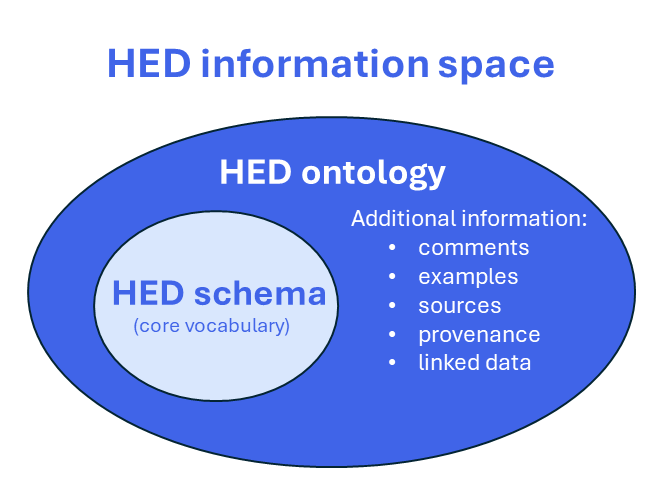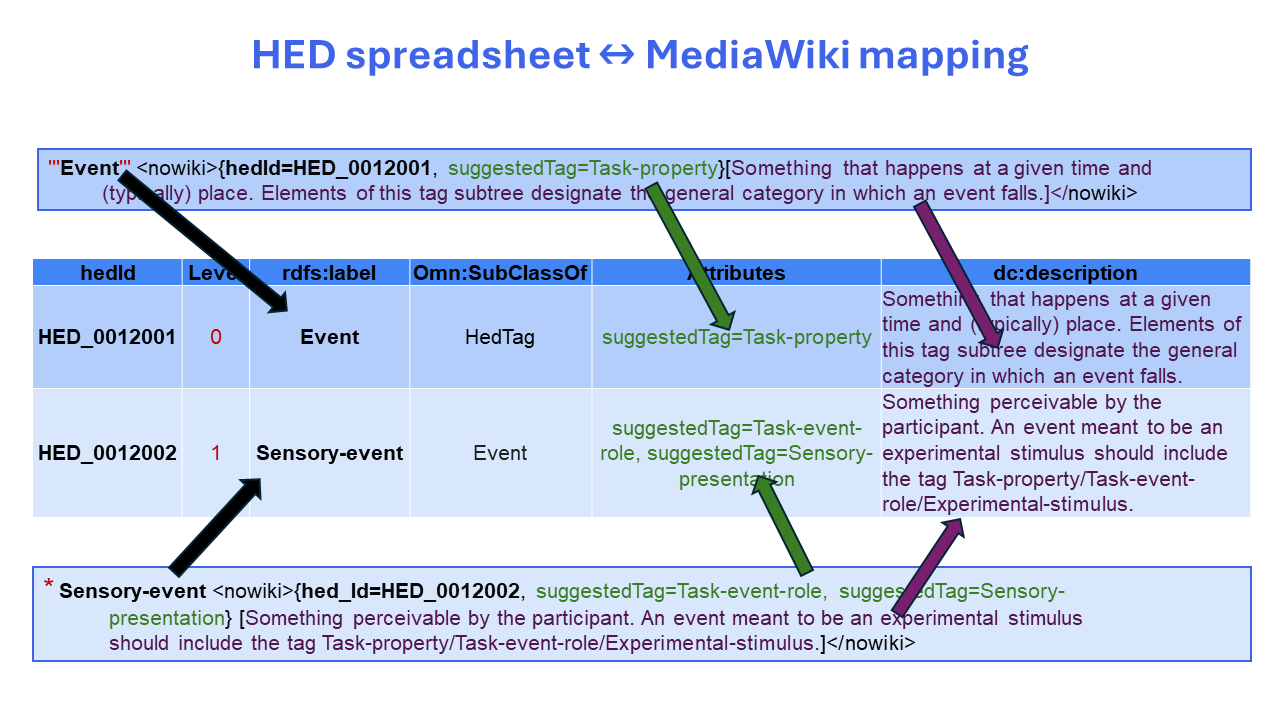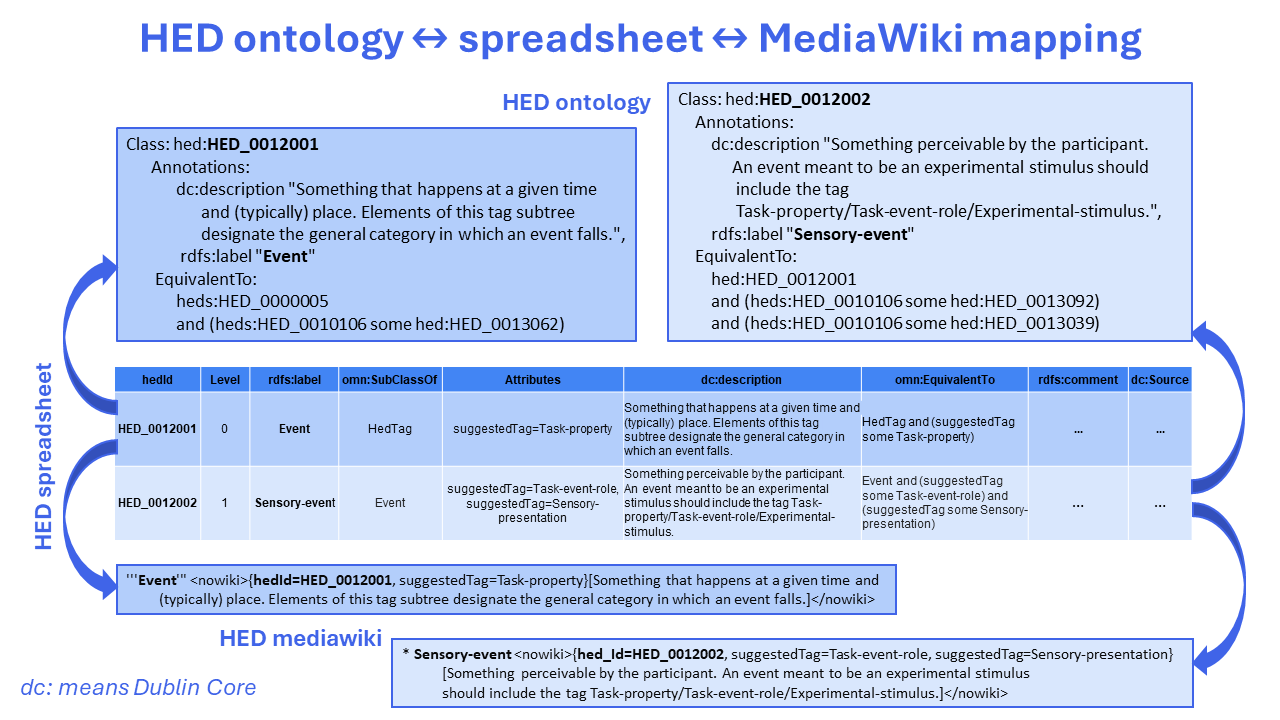8. The HED ontology¶
——–DRAFT DRAFT DRAFT DRAFT DRAFT ————
This chapter defines the HED ontology and explains the relationship between the HED ontology and the HED schema.
The hed: prefix is the abbreviation for HED’s
IRI (International Resource Identifier) prefix.
Terms with this prefix are associated with a particular schema – either the standard schema or a library schema.
Terms with the heds: prefix are structural elements common to all HED schemas.
Both the hed: and heds: namespaces map to the same PURL (Persistent Uniform Resource Locator)
as explained in 8.3 HED global identifiers.
Terms with the rdfs: prefix are from the
RDF Schema (i.e., the Resource Description Framework Schema).
Terms with the dc: prefix are drawn from the
DublinCore Ontology.
Finally, the GitHub source repository for the HED ontologies is hed-ontology. The GitHub source repository for the HED schemas is hed-schemas.
8.1. HED views and representations¶
8.1.1. The annotator’s view¶
HED (Hierarchical Event Descriptors) has a standard hierarchically-organized vocabulary (the HED standard schema) and additional community-specific vocabularies (HED library schemas) that can be used to annotate and analyze experimental data. The HED vocabularies and the supporting HED ecosystem are designed to support these activities.
The data annotator’s natural view is top-down – identifying a general category and then filling out the details with more specific tags in that category or grouping with descriptive tags from other categories. As illustrated in the following diagram, the HED schema hierarchy is organized in a top-down manner to support this work-flow.

In the diagram, top-level tags S1, S4, and L6 represent general categories
and are roots of subtrees organized so that child nodes are more specific terms.
HED supports “search generality”, so searches may specify an exact match or matches any term in a particular subtree.
In the latter case a search for Event may also match Sensory-event or Agent-action or any other descendent of
Event.
The HED schema viewer, allows users to focus on top-level categories or expand the hierarchy view to any specified level of detail.
8.1.2. The ontologist’s view¶
A second view of HED — the HED ontology — provides a mapping between HED schemas and classical ontologies in order to support semantic analysis and reasoning.
The following diagram shows the ontology view of HED. The nodes of the HED schema are embedded in the HED ontology, but the view is “term-centric” or “bottom-up” with links from the given term to its parent class (yellow arrows) and as well links between the given term and other terms (gray arrows).

The ontology represents a complex network of interrelationships among the terms in the HED hierarchy and terms in other ontologies. The HED ontology and its mapping has been made explicit starting with HED standard schema 8.3.0. The goal is to include links to additional information including provenance and examples during annotation and to leverage AI tools during annotation and analysis.
8.1.3. HED information space¶
The HED schema is embedded in a larger information space that includes additional information such as sources, provenance, and links to other ontologies. This HED information space is illustrated schematically in the following diagram.

The embedding is anchored by the hedId schema attribute introduced with HED standard schema 8.3.0.
The hedId values are of the form HED_xxxxxxx and resolve to IRIs (International Resource Identifiers)
of the form https://purl.org/hed/HED_xxxxxxx.
The extended information space is completely represented by the HED ontology in OWL format.
In this document we use OWL Manchester format (.omn) for readability.
8.1.4. HED representations¶
The HED vocabularies have 4 different formats as shown in the following table:
Format |
Content |
Uses |
Editing |
|---|---|---|---|
Mediawiki |
Schema |
Schema development |
Manual editing |
XML |
Schema |
Annotation tools |
Generated from MediaWiki |
Spreadsheet |
Complete |
Schema development |
Manual editing |
OWL |
Complete |
Ontology updating |
Manual editing |
The HED schema, which contains the core HED vocabulary and captures the “annotator’s view” of HED, is completely represented in either the HED MediaWiki and HED XML formats. The HED schema is used for annotation, validation, searching, and most analyses. Tools access the HED schema in its XML format, but schema developers create and update the schema in MediaWiki format, which is easier to read and displays as formatted MarkDown on GitHub.
The HED ontology represents the entire HED information space in OWL (Web Ontology Language). The HED ontology is available in both OWL/RDF format and OWL Manchester format but the examples in this specification use OWL Manchester format for readability.
8.1.4.1. Spreadsheet <–> Mediawiki¶
The HED schema also has a HED spreadsheet representation (with columns containing a tag’s name, parent, attributes, and description). The mapping between the HED MediaWiki format and the HED spreadsheet is illustrated in the following example:

Note: The information about a single tag in the MediaWiki file must be on a single line, but the above diagram has formatted the information so that it will fit within image boundaries.
The mapping of the spreadsheet row and column values to a line in the MediaWiki is further explained in the following table:
Spreadsheet |
Row value |
MediaWiki format |
|---|---|---|
hedId |
xxx |
{hedId=xxx, … other attributes in comma separated list} |
Level |
0 |
This row corresponds to a top-level HED tag. EX: |
Level |
n |
For level n > 0, n asterisks appear in front of |
rdfs:label |
yyy |
The tag’s unique name is yyy. |
omn:SubClassOf |
zzz |
The tag’s parent tag in the HED hierarchy is zzz. |
Attributes |
uuu, vvv, … |
List appearing in curly braces: {hedId=xxx, uuu, vvv, …} |
dc:description |
www |
The contents of the square braces: [www]. |
HED schema developers can develop in either HED MediaWiki or HED spreadsheet (tab-separated-value) file format and
can use tools to update the representations.
Users may NOT assign or modify the hedId in the MediaWiki file.
If adding a new tag to the MediaWiki file, schema developers should omit the hedId.
Tools will assign and validate the hedId during the update process.
8.1.4.2. Spreadsheet <–> Ontology¶
HED spreadsheets have been expanded to include additional columns to capture all the information
contained in the HED ontology as illustrated in the following example.
Notice that while the spreadsheet always refers to the entities by name (e.g., rdfs:label),
the ontology uses the hedId.

Most HED entities (i.e., tags, unit classes, units, unit modifiers, and value classes) map to classes in the HED ontology. The HED schema attributes, which describe properties and behavior, are mapped to ontology properties as described in 8.2.3. Schema attributes section. The HED schema properties, which describe the schema attributes, determine the type of property mapping and are implicitly mapped.
The mapping of the spreadsheet row and column values to a class in the HED ontology is further explained in the following table:
Spreadsheet |
Row value |
Ontology format |
|---|---|---|
hedId |
xxx |
|
Level |
n |
Redundant information – can be recovered using class hierarchy. |
rdfs:label |
yyy |
|
omn:SubClassOf |
zzz |
The tag is either a |
Attributes |
uuu, vvv, … |
If non-empty, then these appear as restrictions |
dc:description |
www |
|
omn:EquivalentTo |
A combination of the information in omn:SubClassOf and Attributes. |
The next section describes the ontology structure in more detail.
8.2. HED schema to ontology¶
Each HED element (tag, unit, unit class, unit modifier, or value class) is associated with a
unique persistent globally unique identifier — the hedId schema attribute value in the
HED schema and the entity ID in the HED ontology.
The structural elements, common to all schemas also have unique assigned identifiers.
The HED schema attributes are part of the HED structural ontology and
The examples in this section
and hed: to represent schema-specific elements.
Both namespaces map to the same PURL (Persistent Uniform Resource Locator).
8.2.1. Overall ontology structure¶
HED requires that child tags of tags in the HED schema satisfy the is-a relationship. This requirement is satisfied in HED ontology using subclass relationship. The HED requirement of orthogonality between tags in different top-level subtrees can be captured in the HED ontology by imposing disjointness on the top-level trees, but this is not currently being enforced.
The following table summarizes how the HED schema and HED ontology are mapped.
Schema |
Ontology |
|---|---|
Header |
Class with
|
Tag |
|
Unit class |
Defined in the
|
Unit |
|
Unit modifier |
|
Value class |
|
Schema attribute |
Maps as a property in the HED ontology:
|
Schema property |
|
8.2.3. Schema attributes¶
The purpose of HED schema attributes is to specify characteristics and/or behavior of HED schema elements, including tags, unit classes, units, unit modifiers, and value classes. These attributes map schema elements into values or into other schema elements.
8.2.3.1. Attribute ontology types¶
A given HED schema attribute’s representation in the HED ontology is determined by its domain, its range, and whether the attribute is inherited. The mapping strategy is summarized in the following table.
Ontology |
Domain |
Range |
Inherited? |
|---|---|---|---|
|
HED entity |
string, numeric, boolean |
No |
|
HED entity |
string, numeric, boolean |
Yes |
|
HED entity |
HED element |
Yes |
DataProperty and ObjectProperty are inherited by subclasses, and reasoners can check their consistency.
AnnotationProperty is not inherited by subclasses, and reasoners ignore them.
8.2.3.2. Schema attribute properties¶
Schema attribute properties appear in the Properties section of a HED schema.
Schema attribute properties determine how schema attributes behave and described in the following table.
Attribute name |
Description |
|---|---|
|
The value is not inherited by child nodes. |
|
The value can be true or false. This property was formerly named |
|
The attribute can apply to any type of element (tag, unit, unit class, unit class, or value class). This property was formerly named |
|
The attribute can apply to node (tag-term) elements. This property was formerly named |
|
The value can be a node (tag). |
|
The value can be numeric. |
|
The value can be a string. |
|
The attribute can apply to unit classes. This property was formerly named |
|
The value can be a unit class. |
|
The attribute can apply to unit modifiers. This property was formerly named |
|
The attribute can apply to units. This property was formerly named |
|
The value can be units. |
|
The attribute can apply to value classes. This property was formerly named |
|
The value can be a value class. |
Each schema attribute property is translated to an AnnotationProperty in the ontology.
8.2.3.3. Attribute representation¶
The following table lists schema attributes with their types (A=AnnotationProperty, D=DataProperty,
and O=ObjectProperty), domains and ranges.
Attribute |
Type |
Domain |
Range |
Handling |
|---|---|---|---|---|
|
D |
|
string |
|
|
D |
|
|
|
|
O |
|
|
|
|
D |
|
|
|
|
|
|
||
|
A |
|
|
Tools: Assign and verify. |
|
D |
|
|
|
|
O |
|
|
|
|
O |
|
|
|
|
A |
|
|
Tools: Verify. |
|
D |
|
|
|
|
A |
|
|
Tools: make tag subclass of tag in range. |
|
D |
|
|
|
|
D |
|
|
|
|
D |
|
|
|
|
O |
|
|
|
|
D |
|
|
|
|
A |
|
|
Only placeholders |
|
D |
|
|
|
|
D |
|
|
|
|
O |
|
|
|
|
D |
|
|
|
|
D |
|
|
|
|
O |
|
|
8.2.3.4. Mediawiki attribute format¶
In the MediaWiki format, schema attributes appear in the Schema Attributes section of the schema.
Example HED MediaWiki representation of a schema attribute.
* extensionAllowed <nowiki>{hedId=HED_0010307,tagDomain, boolRange}[Users can add unlimited levels of child nodes
under this tag. This tag is propagated to child nodes except for
hashtag placeholders.]</nowiki>
Note: this example has line breaks added to fit on the page. Each element in Mediawiki must appear on one line.
The extensionAllowed attribute has a unique `hedId
8.2.3.5. XML attribute format¶
Schema attribute definitions are nested in the <schemaAttributeDefinitions> section of the schema’s XML file.
The format of an individual schema attribute is shown here.
Example HED XML representation of a schema attribute.
<schemaAttributeDefinition>
<name>extensionAllowed</name>
<description>Users can add unlimited levels of child nodes under this tag.
This tag is propagated to child nodes except hashtag placeholders.
</description>
<property>
<name>hedId</name>
<value>HED_0010307</value>
</property>
<property>
<name>tagDomain</name>
</property>
<property>
<name>boolRange</name>
</property>
</schemaAttributeDefinition>
8.2.3.6. OWL format for attributes.¶
The Manchester Owl syntax for schema attributes is similar to that of classes above.
Example HED Manchester OWL syntax for extensionAllowed.
DataProperty: hed:HED_0010307
Annotations:
dc:description "A schema attribute indicating that users can add unlimited levels of child nodes
under this tag. This tag is propagated to child nodes except for hashtag placeholders.",
rdfs:label "extensionAllowed"
Domain:
heds:HED_0000005
Range:
xsd:boolean
Unlike DataProperty and ObjectProperty attributes, AnnotationProperty attributes
are not inherited and do not use domain and range specifications.
These must be handled individual by tools as flagged by the HED schema annotationProperty property.
In the OWL representation, information about the handling should be provided in an rdfs:comment field.
Example HED Manchester OWL syntax for rooted.
AnnotationProperty: heds:HED_0010502
Annotations:
dc:description "This top-level library schema node should have a parent which
is the indicated node in the partnered standard schema.",
rdfs:comment "Maps a HedTag into a HedTag name as a string.",
rdfs:label "rooted"
8.2.4 Other auxiliary sections¶
The schema-ontology mapping for HED schema units, unit classes, unit modifiers, and value classes is similar to that of HED tags. However, each of these auxiliary items should inherit from a superclass tied to the schema in which they are defined.
For example the value classes that are defined in the standard schema should inherit from
StandardValueClass (hed:HED_0010009) not directly from HedValueClass (heds:0000009).
8.3. HED global identifiers¶
8.3.1. Schema identifiers¶
The HED tags in each HED schema are unique, so a HED tag is uniquely identified by its name (label) and schema version. If the tag is from a library schema, the library name is part of the version. The rules for updating HED version numbers are specified in HED semantic versioning.
Starting with HED schema version 8.2.0 (released April 28, 2023), HED library schemas are strongly recommended to be partnered with a standard schema. Partnered schemas are joined with a specific version of the standard schema and are treated as a single integrated vocabulary for annotation and analysis. Partnered schemas MUST not have name conflicts with their standard schema partner.
Lazy partnering, introduced with HED schema version 8.3.0, allows any number of library schemas to be loaded into a single integrated vocabulary provided they are partnered with the same version of the standard schema and there are no name conflicts. If there are conflicts, user-selected namespace prefixes must be used in the version specification and in annotations to resolve the conflicts.
8.3.2. Ontology namespace¶
The HED ontology uses GUIDs (Global Universal Identifiers) of the form HED_xxxxxxx for all entities of HED schemas.
All HED standard and library schema entities are mapped to the HED_xxxxxxx namespace
using the range assignments described in the following table.
HED ID |
Owl type |
Description |
|---|---|---|
HED_0000001- |
|
HED schema structure (EX: |
HED_0000100- |
|
Common object function (EX: |
HED_0000300- |
|
Common data function (EX: |
HED_0000500- |
|
Currently not used. |
HED_0010001- |
|
Standard schema structure (EX: |
HED_0010100- |
|
Standard schema object function (EX: |
HED_0010300- |
|
Standard schema data function (EX: |
HED_0010500- |
|
Standard schema property not inherited (EX: |
HED_0010700- |
|
Standard schema attribute property (EX: |
HED_0011300- |
|
Standard schema value class (EX: |
HED_0011400- |
|
Standard schema unit modifier (EX: |
HED_0011500- |
|
Standard schema unit class (EX: |
HED_0011600- |
|
Standard schema unit (EX: |
HED_0012000- |
|
Standard schema HED tag (EX: |
HED_0042000- |
|
SCORE schema HED tag (EX: |
HED_0062000- |
|
LANG schema HED tag. |
8.3.3. HED IRIs¶
HED IRIs (International Resource Identifiers) are mapped to https://purl.org/hed.